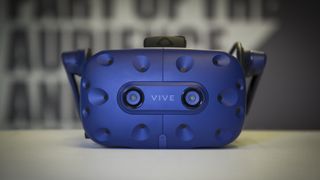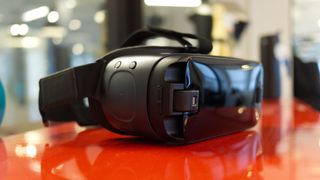Best business VR headsets of 2024: top virtual reality for enterprise use
Our pick of the best business VR headsets

The best business VR headsets prove that virtual reality is not just for gamers. In fact, there are plenty of productivity-related uses for one of these. Architects can visualize the end results of their blueprints. Business associates based in different areas of the world can connect in more meaningful ways. And, products can be designed in a three-dimensional space or showcased to potential customers before being manufactured.
The only real limitations are price and hardware. Luckily, while a number of enterprise-level VR headsets still need a high-end rig like some of the best PCs to power them and cost an arm and a leg, affordable options perfect for business use are more plentiful than ever much like commercial VR headsets. And, thanks to Microsoft's Windows Mixed Reality platform, we’ve seen the arrival of a number of affordable headsets from the likes of Dell and HP.
To help you find the best VR headsets to take your business into the VR world in 2022, we’ve gathered our top picks, taking performance, comfort, and affordability into account. We've compared these business VR headsets across multiple aspects, from their resolution and refresh rate to their performance and comfort. We evaluated their CPU/GPU requirements, weight, setup process, and pricing, among other aspects.
No matter your budget, there’s something for you. And, with our price comparison tool, you might even score an excellent VR deal.
We've also reviewed the best business webcams.
The best business VR headsets of 2024 in full
Why you can trust TechRadar

Specifications
Reasons to buy
Reasons to avoid
If you want the very best VR experience for your business, then the HTC Vive Pro is currently our pick for the best business VR headset.
It comes with a resolution of 2880 x 1600, offering a 78% increase in dots per inch than the standard HTC Vive. This leads to astounding image quality, so if realistic graphics are important, this headset is worth considering.
It also includes built-in headphones and new nose guards that do a better job of blocking out light than the HTC Vive. Setup is a bit complicated and could take between a few minutes to a few hours because you need to install lighthouses (small boxes) around the office to track the HTC Vive Pro. It's also one of the most expensive headsets in this guide.
Read the full review: HTC Vive Pro

Specifications
Reasons to buy
Reasons to avoid
There’s little doubt that the Valve Index is the next-generation VR headset people have been clamoring for: it has an ultra-crisp display that runs fairly well even with older GPUs, a wider field of view, a higher refresh rate and Valve’s 'knuckle' controllers, which can track the movement of every finger.
It's by far the best virtual reality headset for gamers, but it's also a great VR headset for business use as well. It offers a significant upgrade to the HTC Vive, and runs much smoother than the Vive Pro.
While its game-orientated design means you might be paying for features you won't be using in a business environment, and setting the thing up can be a bit of a pain, if you can look past those issues, this is a really good VR headset. Its higher-resolution screen and better refresh rate allowed us to use it for longer periods of time without discomfort, and the Index Controllers are a real step up from the ones that ship with the Vive.
It's expensive, yes—and at the moment stock can be hard to come by—but for the gamers who want next-level VR, the Valve Index is the only way to go.
Read the full review: Valve Index

Specifications
Reasons to buy
Reasons to avoid
You don’t want to lug around a VR-capable PC when using a VR headset on the road, like when you’re visiting customers and clients at their offices. And, with the Oculus Quest 2, you don’t have to.
There’s no need for wires or extra equipment. It’s incredibly easy to use and comfortable to wear. It allows you to experience 360-degree content and has a sharper 1832 x 1920 per eye resolution compared to its predecessor, which was 1440 x 1600 per eye.
Unfortunately, the new model also requires you to connect to Facebook and has introduced ads. Yet, it is still incredibly accessible and feature-rich despite its few shortcomings. And, though it is probably the best VR headset around, you can get even more out of it when connecting to a VR-capable PC.
Read the full review: Oculus Quest 2

Specifications
Reasons to buy
Reasons to avoid
As we mentioned at the beginning of this guide, Windows Mixed Reality headsets offer a brilliant VR experience for businesses, and the Samsung HMD Odyssey is currently the best WMR headset yet.
While not exactly on par with the Oculus Rift and HTC Vive in terms of sheer graphics rendering, it comes very close, with excellent build quality and performance. The screens pop with a resolution of 1,440 x 1,600 pixels per side and a refresh rate of between 90 to 60Hz.
This is a higher resolution that most other Windows Mixed Reality Headsets, and puts it in the same league as the HTC Vive Pro, though less pricey. It is the most expensive WMR headset, however, at $499 (about £377, AU$635). But, it’s the only one to include built-in headphones with spatial audio.
Read the full review: Samsung HMD Odyssey

Specifications
Reasons to buy
Reasons to avoid
If the HTC Vive Pro (listed above) is too expensive for your budget, then the original HTC Vive is a more affordable (but still expensive) choice. It features room-scale tracking that lets you to walk around a space that's 4.5 x 4.5m big, which adds immersion to anyone using it – though, of course, you'll need plenty of space to make use of it.
The headset features two 1080p screens, which is fine for most use cases, though the HTC Vive Pro comes with a 78% increase in dots per inch, which offers a much sharper screen in addition to built-in audio, which the original Vive lacks.
However, despite not being the latest and greatest Vive, the fact that it has seen some decent price drops makes this one of the best business VR headsets around.
Read the full review: HTC Vive

Specifications
Reasons to buy
Reasons to avoid
While the Oculus Rift S is more of an update than a true next-generation version of the Oculus Rift, it is still a step forward for one of the most popular PC VR headsets out there. While the S lowers the refresh rate over its predecessor, it improves on resolution for a sharper image.
Facebook, who bought Oculus a few years ago, has also made sure that the Rift S is backwards compatible so you’ll be able to dip into your old app library without having to repurchase any important programs.
The headset does have some stability issues, which is a bit concerning. With that said, this headset is among the most affordable out there and is able to deliver ‘room-scale’ experiences, making it an easy addition to any business VR setup.
Read the full review: Oculus Rift S

Specifications
Reasons to buy
Reasons to avoid
Samsung Gear VR is the best mobile virtual reality headset, and now that it has a motion controller, it's better than ever. In addition to the new controller, the updated Gear VR is lighter and more streamlined, and features a USB-C connector that hooks directly to a Samsung Galaxy phone.
You don't need to bring a PC or laptop with you to power the Samsung Gear VR, which makes it brilliant for using when out on the road. You do need a Samsung smartphone, however, such as the Galaxy S8 and Galaxy S8 Plus, as well as the Galaxy S10 and Galaxy S10 Plus.
The included motion controller is similar to the HTC Vive controller design, with a touchpad and trigger button. If you have a Samsung smartphone and want to use VR for your business, this is a great choice.
Read the full review: Samsung Gear VR
How to choose the best business VR headsets for you?
When choosing the best business VR headset, you'll first want to consider your budget and whether you want a standalone VR headset or a PC VR. While a standalone VR headset lacks cables and houses the CPU and GPU within, a PC VR relies on the computing power of the PC it's connected to and restricts user movement. But the latter typically offers better performance since it relies on an external computer's power.
You'll want to evaluate the headset's setup process in terms of how simple it is and how long it takes to complete. Make sure to assess basic technical aspects, like the headset's resolution, ambient light blockage, field of view, refresh rate, availability of built-in headphones, and weight.
The best business VR headsets: How we test
We tested several VR headsets to determine the best ones for business use. We checked their technical specifications, like the resolution, field of view, refresh rate, audio quality, connectivity, and controller quality.
We included both types of headsets in our list: standalone and PC VR. We evaluated how easy their setup process was and how long it took.
Along with their overall performance, we also assessed their ambient light blockage, weight, comfort, design, and CPU/GPU requirements, among other things.
Are you a pro? Subscribe to our newsletter
Sign up to the TechRadar Pro newsletter to get all the top news, opinion, features and guidance your business needs to succeed!

Matt is TechRadar's Managing Editor for Core Tech, looking after computing and mobile technology. Having written for a number of publications such as PC Plus, PC Format, T3 and Linux Format, there's no aspect of technology that Matt isn't passionate about, especially computing and PC gaming. Ever since he got an Amiga A500+ for Christmas in 1991, he's loved using (and playing on) computers, and will talk endlessly about how The Secret of Monkey Island is the best game ever made.
